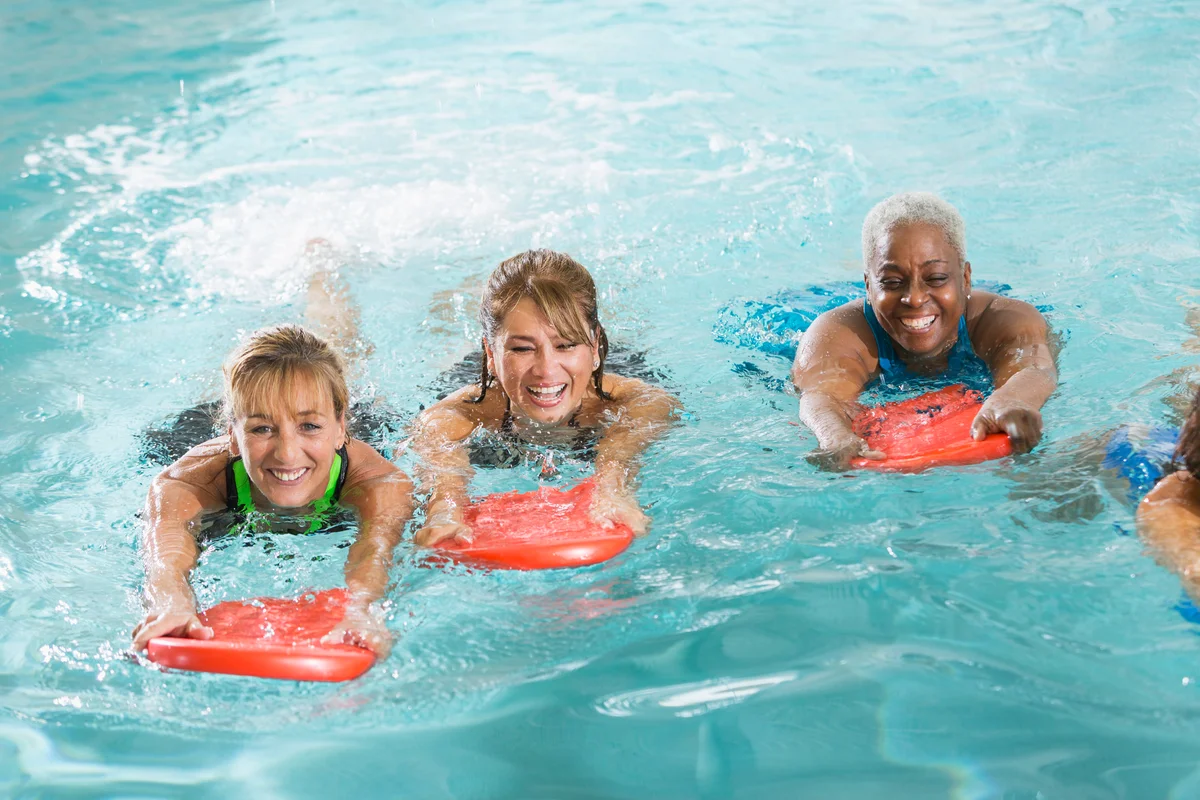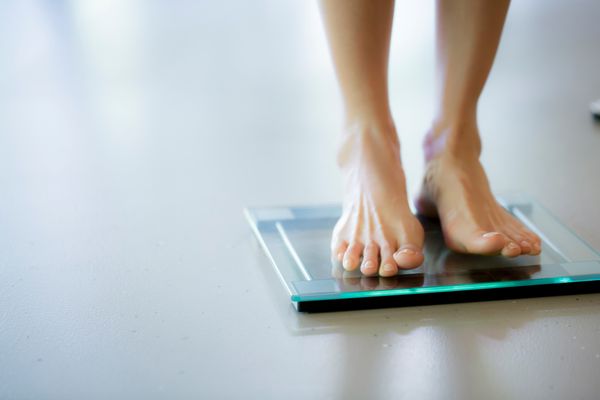OK, so that was a trick question. Maybe buoyancy doesn't count as a weight-loss strategy when you return to land, but it explains why exercising in a pool is easy on the body—any body.
Although it's not an instant solution, water exercise provides a good fitness result—quickly. That's because, unlike physical activity on dry land, when you work out in water there's natural resistance and no gravity. So your muscles do more work, but you feel it less. Your heart rate is also lower during aerobic activity in the pool than when exercising on land, yet you get the same cardiovascular benefits.
The changing face of water exercise
Time was when there were only two groups of people who used water for exercise: dedicated lap swimmers whose powerful strokes and strong pace would often push slower and less steady swimmers right out of the pool; and older folks, often women, who participated in aqua classes best known for scratchy music and retro bathing caps.
That was then; this is now. Just as our understanding of what makes for good exercise on land has evolved, so, too, has our knowledge of water-based workouts. Today's water exercise is less a test of endurance, like lap swimming, or a throwback to a disco-music-soaked era, and more of a well-rounded workout for everyone.
Yes, it's still perfect for athletes and grandmothers (and for grandmothers who are athletes), but working out in a pool is also terrific for women who haven't done any physical activity in recent memory, those who walk or run regularly, pregnant women, folks with chronic conditions such as osteoarthritis and fibromyalgia, women who love going to the gym, women who hate going to the gym, women who are overweight, and, well, you get the picture.
Now there are special shoes for pool walking, buoyancy belts and vests for deep-water-running (only for swimmers who are comfortable in deep water), webbed gloves and water weights that add resistance to arm movements, and even a form of pool-based tai chi called ai chi.
Resistance without weight
Pool exercise builds your strength in much the same way as do weight machines at a fitness club or flexible rubber tubing you might use at home. "You need to look at the pool as a giant resistance machine," says Carol A. Kennedy-Armbruster, MS, a water exercise specialist and instructor in the kinesiology department of the School of Health, Physical Education, and Recreation at Indiana University in Bloomington, Indiana.
Even the simplest pool exercise—walking forward and backward in waist-high water—improves your balance, trains the core muscles of your abdomen, increases your flexibility and boosts cardiovascular fitness. You'll also burn calories, reduce fat and lose weight at the same rate as working out on land.
"These exercises are awesome for anyone to do," Kennedy-Armbruster says.
Water also soothes and massages with light pressure (called hydrostatic pressure) while it helps strengthen. That safe, therapeutic environment makes pool exercise good for athletes and others recuperating from sports injuries or illness and for those who need to eliminate joint stress. The calm movement of pool water soothes and relaxes the spirit as well.
Getting started
If you have health concerns, check with the water exercise instructor (if you're taking a class) and your health care provider to make sure the activity is appropriate for you. Start your pool workout in water depth that matches your swimming ability. Never rely on a buoyancy device to keep you safe in water that's too deep for your skills.
That said, you don't need much equipment to work out in water—just a bathing suit and, perhaps, water shoes (pool walking can cause sore feet from rough bottom surfaces). Kennedy-Armbruster advises beginners to wear inexpensive water shoes, such as those sold in discount stores. You can move up to athletic-quality pool shoes (worn by many instructors) later, if you wish.
She also recommends not adding strength-building gear such as webbed gloves and water weights until you've spent four to six weeks doing pool exercises and getting used to the resistance of the water. Be sure to check with the organization running your pool about which types of equipment are permissible. You may have to explain that buoyancy belts and hand webs aren't flotation devices or water toys, which many pools prohibit.
Water Walking 101
If you're accustomed to walking on land for exercise, get ready to slow things down in the water. According to Kennedy-Armbruster, in pool walking you have to decrease your walking speed by one-third to one-half of what it is on land.
"That's because of the viscosity of the water," she says. "You have to slow down your movement in order to keep the correct form." As your strength increases, you can progressively increase your pace. "It will make land walking a lot easier," she adds.
If you're exercising in an outdoor pool, apply sunscreen with an SPF of at least 15 (30 is better) at least 20 minutes before going outdoors. Reapply after being in the water. For more on the latest sunscreen advice for all skin tones, click here.
Waist-high water is best for water walking. Below are several good routines, recommended by Kennedy-Armbruster. Beginners should not do these exercises all at once since they increase in difficulty. Be sure you can perform each comfortably before moving on to the next:
Pool Exercise #1
- Walk 1 or more laps, according to your comfort level. (To stay in waist-high water, you might have to walk from side to side in the pool, instead of from one end to the other).
- If an average lap takes you 35 seconds to walk, see if you can cut a few seconds off that speed for a lap or 2.
- Then return to your original speed.
- When comfortable, try walking one lap facing forward and the next lap backward. This builds both your abdominal and back muscles.
Pool Exercise #2
- Walk 2 laps (warm-up).
- Hold onto side of pool, extending outer leg out to the side. You can bend your leg to hold it up, if that's easier for you. Extending the leg fully works your hip and muscles more.
- Rotate the leg, according to your ability (3 to 12 times).
- Lower leg to pool bottom and turn, switching sides, so the other leg is on the outside.
- Holding onto the side of the pool, repeat the extension and hip rotation movement on the other leg.
Pool Exercise #3
- Do this only after Pool Exercise #2 becomes easy.
- Walk 2 laps (warm-up).
- Hold onto side of pool, extending outer leg out to the side.
- Let go of the pool wall and do the hip rotations without holding on. This helps to build balance skills.
- Change sides and repeat for other leg.
Pool Exercise #4
- Do this only after Pool Exercise #3 becomes easy.
- Walk 2 laps (warm-up).
- Hold onto side of pool, extending outer leg out to the side.
- Let go of the pool wall. Raise your hands up and out of the water.
- Do the leg rotations with your hands in the air. This builds your core as your abdominal muscles work to stabilize you in an upright position. Tip: keep your shoulders over your hips.
- Change sides and repeat for other leg.
Pool Exercise #5
- Do this only after Pool Exercise #4 becomes easy.
- Walk 2 laps (warm-up).
- Hold onto side of pool, extending outer leg out to the side.
- Close your eyes while doing the leg rotations. Slowly let go of the pool wall.
- Change sides and repeat for other leg.
Be sure to do 5 to 10 minutes of warm-up and cool-down movements. Slow, controlled water walking and stretching work great.







